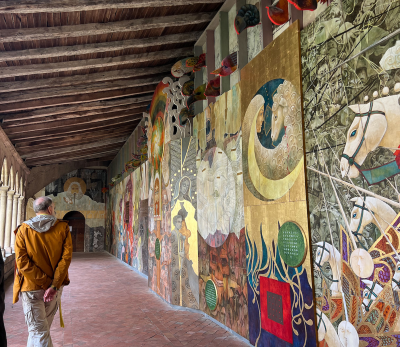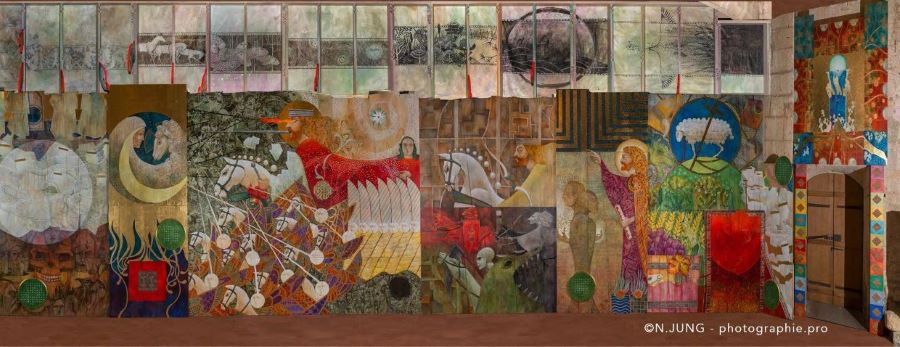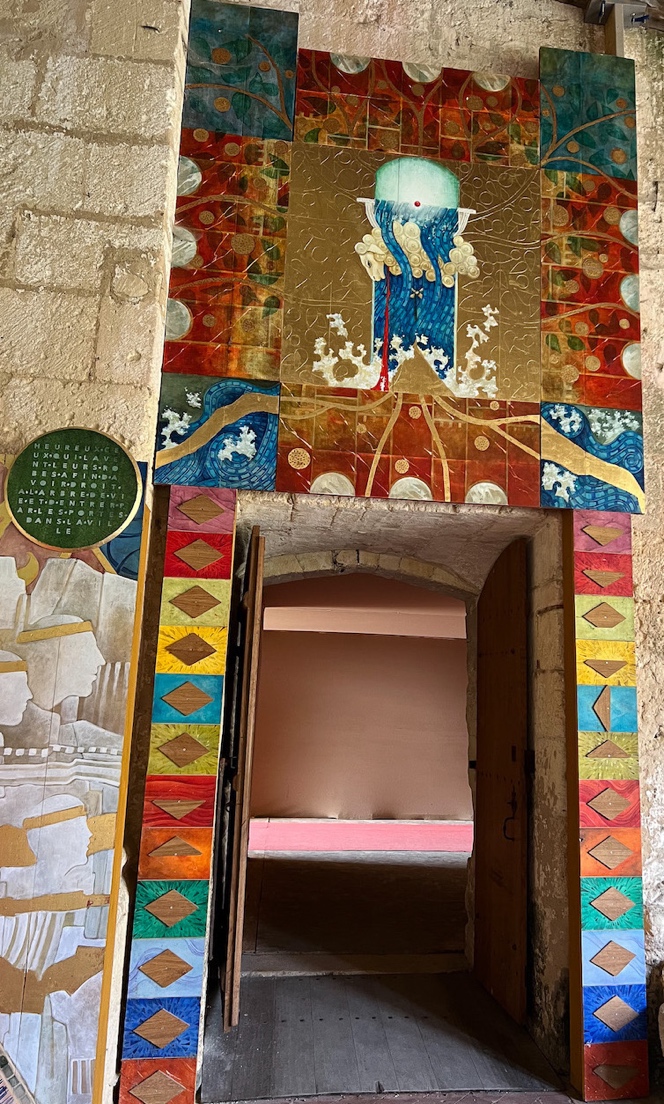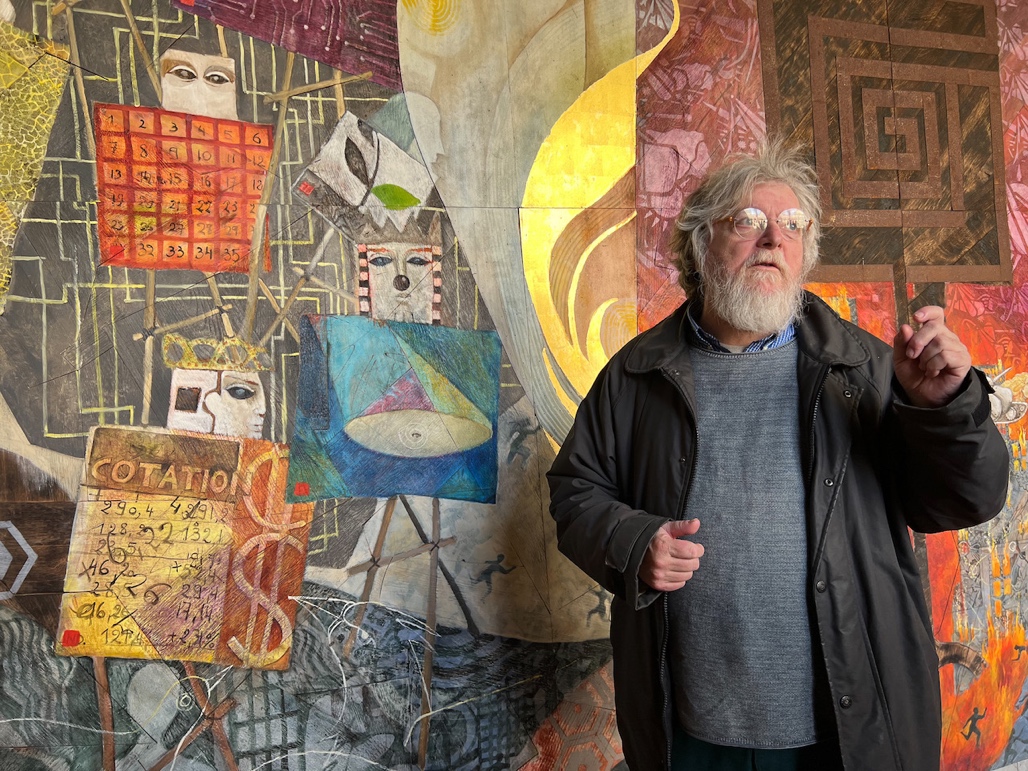Peltier, François - VM - Elria Kwant
François Peltier: The Apocalypse of Saint-Émilion

A Revelation to Arrest Secular Hearts
by Elria Kwant
The Apocalypse of Saint-Émilion, according to St John is a monumental painting, installed in the cloister courtyard of the Collegiate Church of Saint-Émilion, an active Catholic community near Bordeaux in the wine region of Southwestern France. The artist, François Peltier, lives locally. The painting – 38.5 metres wide and 5 metres high – was completed in 2018.
Peltier studied painting at the Royal Academy of Fine Arts in Brussels, Belgium. Drawn to the Flemish Primitives, he trained in the old Flemish technique of glazing, a slow way of painting with a luminous result. A turning point in his life came after completing a mural, The Way of the Cross, in the Church of Notre-Dame at Bias where Peltier lives, not far from St Émilion. He would devote the rest of his life to ‘sacred art’ in the Catholic tradition, that is art as both an apologetic of the faith and a catechesis in faith. It is art “oriented toward the infinite beauty of God ... to God's praise and glory ... to the single aim of turning men's minds devoutly toward God” (Sacrosanctum Concilium, 122).
When Father Emeric de Rozières, parish priest of the Collegiate Church, saw Peltier’s The Way of the Cross, he had the idea for a series of Apocalypse paintings so beautiful they would arrest the thousands of visitors yearly passing through Saint-Emilion and its historic monolithic church. Concerned about the secularization of his nation, the loss of hope he perceived, and the widespread confusion of so many, he longed for beauty that would communicate hope and reveal God’s love.
Peltier’s first attempts were disappointing to both him and Father de Rozières, who firmly responded: “You did not achieve a satisfactory result because you do not have sufficient knowledge of the text and you are distracted by your other work. The Apocalypse requires a total immersion in the text. You are therefore going to refuse all the other proposals and devote yourself exclusively to the Apocalypse of Saint-Emilion. For this, the Parish will provide for your daily bread and we will seek donors to finance the work itself. You have a year ahead of you.” This released Peltier to immerse himself in the biblical text for six months, including discussions with theologians and priests, before setting to work again. The result is stunningly beautiful, joyful, and bright. It overwhelms you, with so much happening simultaneously at so many levels. The painting is framed at the top with a frieze referring to the Genesis creation account, for the Apocalypse involves the whole biblical story, beginning to end.

Left side with the St. John's Door (left) and the Door of Christ (right)

Right side with on the right the New Jerusalem Door
The location prompted Peltier to structure the painting around three doors: the St John’s Door, where visitors enter from the tourist office, depicting the prologue; a full-length ‘double-door’ constructed in the centre (of the biblical vision as well as the painting), depicting the Vision of God (the ‘contemplative’ Trinity) through the Door of Christ, which separates the ‘good’ side (viewer’s right) from the ‘dark’ side (viewer’s left); and the New Jerusalem Door, where visitors exit into the Collegiate Church on their way out.

Leaving the cloister into the church by the New Jerusalem Door
Peltier uses contemporary materials, applied with an old technique in a novel way. His symbols have iconic, ethnic, ecological and modern allusions, and he speaks of ‘writing’ his painting. There are flicks, waves and avalanches of gold, symbolizing the presence of God, both on the ‘good’ and ‘dark’ sides: because God reaches in, and is always reachable, however hopeless the circumstances. The face of Jesus, for example, arrests as an icon, his hair resembling the ‘curls’ of the lamb.

The painter, François Peltier, explaining some of the symbols on the “dark” side
As visitors walk through, some are moved, all are delighted, most are completely at a loss to the meaning of what they see. It reminded me of the Dutch art historian, Hans Rookmaaker’s remark, “We see what we know.” We also know because something was revealed. So the artist included seven ‘seals’, each bearing the words of one of the ‘beatitudes’ of the Apocalypse. May many, ‘mingling’ with the painted crowd in white robes as they exit under the representation of the river of life flowing from the throne and the Lamb, see for the first time or again, how to enter.
“Blessed are those who wash their robes, that they may have the right to the tree of life and may go through the gates into the city!” (Revelation 22:14)
*******
The Apocalypse of Saint-Émilion according to St John (2015-2018) is located in the cloister of the medieval Collegiate Church of Saint-Émilion at Saint-Émilion at the heart a designated UNESCO World heritage site near Bordeaux, France. It is open to visitors. Contact the website of the tourist office at https://www.saint-emilion-tourisme.com/uk/1-discover/31-the-12-inescapable-monuments/4-the-collegiate-church-and-its-cloister.html
Recommended video: Une vision de Apocalypse (2018), https://www.lejourduseigneur.com/videos/francois-peltier-une-vision-de-lapocalypse-2213
François Peltier was born on 7 September 1955 at Caudéran, today a quartier of Bordeaux, France. After attending Collège Saint-Joseph in Sarlat and the European School of Luxembourg, he decided, aged 15, to become a painter. He had a passion for the Flemish Primitives, and went to Brussels (Belgium) to attend courses at the Académie Royale des Beaux-Arts (the Royal Academy of Fine Arts). He graduated in 1978 with honours in painting (Diplôme Supérieur de Peinture de Chevalet). Peltier later trained at the Manufacture d'Estampes et de Livres d'Art in Brussels (Belgium) under Maître-Pressier André Colpin. Since 1979, he has dedicated himself entirely to painting and his work has been included in private collections in 15 countries. The artist can be contacted via his website at http://www.favolus.com
Elria Kwant is an enthusiast supporter of the arts and dabbler in writing. She grew up in South Africa during the Apartheid years. Elria is married to Pieter Kwant and has lived in the UK since 1987. Pieter and Elria have four grown-up, married children and eleven grand-children. Together with Pieter, Elria has been involved in Christian literature over the years. Since 1995 she has worked as freelance editor, mainly on large missions projects. Pieter retired from his role as Publishing Director for Langham Partnership at the end of 2022. The couple continue to run their own small publishing/literary agency, Piquant, started in 1999. The arts have been a lifelong interest, ever since their introduction to the complete works, and legacy, of Rookmaaker at Dutch L’Abri!
ArtWay Visual Meditation 10 September 2023


